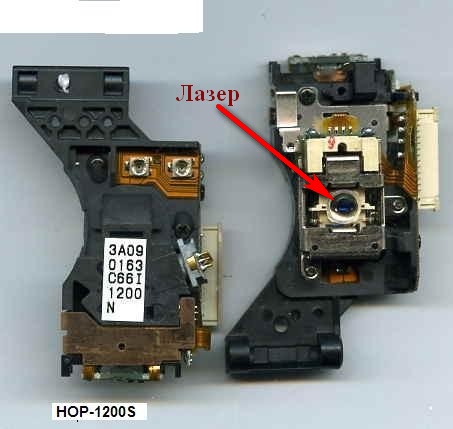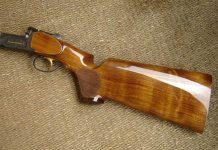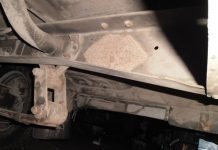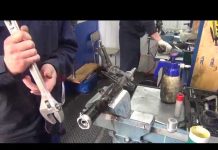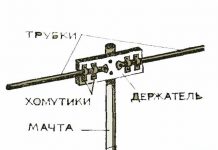In detail: DIY laser head repair from a real master for the site my.housecope.com.
In many CD-ROM drives, the first cause of failure is the laser head unit.
In this block, there are at least 3 reasons:
.
You can discuss, add your ideas and considerations.
I will also say that 49 devices out of 57 sidiromes and 12 simple players have successfully started working (this applies to heads).
on the rest, I didn’t find details.
Some troubleshooting methods:
.
First of all, you need to check the laser power on the board. It is usually around 1.5 volts.
Further along the train to the head, and then to the laser.
If there is power, but the glow is not visible, it is necessary to check the variable resistance, which is located on the head.
I want to warn you right away. Excessive rotation of the resistance can damage the semiconductor of the laser.
You can rotate no more than 15-20% in both directions.
Sometimes the laser is working, and by rotating the resistance, everything is restored.
But as often happens, the laser just got hooked, and here again resistance helps. By turning it one degree at a time in different directions, I achieve stable operation of the head.
Although this method helps, it still leaves much to be desired. Someday it may happen again.
If the laser is not working, it can be changed.
This procedure is painless. It is enough to unsolder and carefully remove the old laser, clean the glue from the seat and insert a new one there.
You can get it from other non-working heads.
(Although the variety of heads is large enough, the lasers are almost the same for all.)
After installing a new laser, almost no adjustments are required.
All that remains is to adjust the resistance for stable operation of the head.
| Video (click to play). |
Usually this block does not pay any attention to itself, but I will describe a couple of cases.
The positioning coils are virtually unbreakable. I have not had such cases.
The lens remains. With her there were only problems with the sidir. In 30% of cases, the lens deforms due to overheating of the housing, after which all optics are thrown away.
Replacing the magneto-optical unit helps in these cases. The difficulty lies in the fact that you need to accurately align the lens.
Many heads have the ability to adjust the angle of the laser in relation to the disc.
This can be done with vignettes. Some are soldered and often glued.
I did it like this:
The drive is disassembled to such an extent that the gap between the disc and the lens can be seen. We put on the compact and, with sufficient illumination, look at the lens and its reflection on the disc. If the setting is incorrect, the distance between the right and left edges of the lens before its reflection on the disc will be different. Now you just need to change the angle of the magneto-optical unit so that the lens surface is parallel to the surface of its reflection.
After this method, all sodiroms work, without talking about centers and other equipment.
The most difficult thing is the photodetector. It is he who delivers all the troubles and inconveniences.
The main thing is to make sure that this is the reason.
In most cases, the laser and the receiver are separate units, but it also happens in the same housing.
As for the receiver, this is a whole microcircuit. It also appears in other heads. There are 8pin and 10pin.
The microcircuit is soldered on to a small board that is glued to the head body.
It is possible to carefully remove, unsolder and solder the new MC immediately, but it is very difficult to fix it precisely. But after 5-6 attempts, you gain experience and it can work out.
It is necessary to slightly strip the glue from the old MC and glue the new one.
I glued with glue for false ceilings. It is thick and does not dry out immediately.Smear a little and, with the drive turned on, try to find such a position when the disc is detected. It remains only to fix this position.
This method is laborious, requires precision and perseverance.
That's all for now. As soon as there is a new opening, I will inform you.
Laser drives are widely used in electronics. Any DVD-player, CD / MP3-tape recorder, music center are equipped with a laser drive.
In most cases, such devices are repaired precisely because of the breakdown of laser drives.
Malfunctions caused by a breakdown of a laser drive are quite similar, and boil down to one thing - either the laser disc cannot be read, or the playback of music (CD / MP3) or video (DVD) fails.
It should be noted that the service life of a laser diode, which is included in any disk apparatus, is on average 3-5 years. It would be naive to think that a DVD player will last 10 years or more! Take a look at your DVD player manual ...
In general, the first thing to ask when a disk apparatus is brought to you for repair is how old the apparatus has been and how intensively it has been used. If the answer is 3 or more years, then the probability that the optical unit is faulty increases dramatically. How often the device was used is also important, because a laser drive is an electronic-mechanical device. The number of miniature motors in one laser drive is unlikely to be less than 2-3.
The first of the three - spindle drive. He is responsible for spinning up the laser disc. A very large number of malfunctions are associated with it. Here's an example.
Second - optical block drive. This drive is responsible for positioning the laser head along the disc. It rarely fails.
Third - loading / unloading drive (LOAD). Unloading and loading the disk into the drive. Malfunctions of this engine are quite rare and usually easy to repair.
In practice, such a malfunction is common. Mostly in CD / MP3 car radios.
The sound often disappears during playback. It appears abruptly and also disappears. Stuttering is present.
Have DVD players the malfunction manifests itself as follows.
The disc is read for a very long time, after which the display shows (ERROR or NO DISK). The disk may freeze up accidentally. Reinserting the disc solves the problem and the recorded disc plays back normally.
The reason for this "incomprehensible" behavior is not associated with a malfunction of the optical laser unit, but with a malfunction of the spindle drive.
The fact is that the spindle motor must spin up at a certain speed. The speed is adjusted by a feedback system. So don't think that the disc is spinning by itself. Applied 3 volts to the engine and that's it! Not! The rotational speed of the disk is regulated by a complex adjustment system. If the spindle motor is defective, then even the correction system does not handle well and malfunctions occur. The engine does not give out the required rpm, it “fails”.
Therefore, if the malfunction described below appears, do not rush to replace the optical laser unit!
Replacing the spindle drive is cheaper than buying an optical laser unit. You can temporarily replace the drive with a motor from another device or find a suitable one in the store.
A very common problem with CD / MP3 recorders with vertical disc installation.
The disc spins up, but the disc does not load. Writes ERROR or NO DISK.
The optical laser unit is afraid of dust and dirt... A thin finely dispersed dust deposit on the upper lens is enough for the disc to stop being read. Vertical disc recorders are more vulnerable to dust, the disc is loaded from above and the amount of dust that gets in increases.
Disc car radios in this case are more protected, they have a slot loading disc.
Fine dust deposits can be removed from the surface of the lens of the laser unit with an ordinary cotton swab or just a piece of cotton wool.Moisten cotton wool with cleaning agents no need, you can ruin the lens! Using a cotton swab 3-4 times on the surface of the lens in a circular motion. Making sure that there are no residues of coarse dust on the lens and that's it!
Do not press on the lens, it is attached to spring cables! They supply power to the focusing electromagnet. They are quite sturdy, but with excessive force they can be damaged.
It is not uncommon that after such a simple cleaning, the operation of the device is completely restored.
The main difficulty in this operation is to properly disassemble the device and get to the laser head. This is most difficult for music centers with a 3-disc loading unit or a changer (when the discs are placed in a box - like plates in a dryer), as well as for car CD / MP3 players and DVD players with a slot loading disc.
Therefore, on the pages of the site, I posted information on disassembling all kinds of CD drives:
These techniques will help if you need to disassemble a CD drive, but there is no experience in this matter.
Sometimes cleaning the lens does not help. The reason is that there is a prism inside the optical unit, dust will settle on it over time. It makes no sense to disassemble the optical unit. Better to replace the entire block.
When repairing electronics with faults that clearly indicate a defect in the laser drive, you can use the following techniques:
Check the mechanical part of the laser drive for jammed gears, carriages, serviceability of flexible connecting cables. It is better to “ring” flexible cables with a multimeter, and it is better to check with a replacement. Very often, the loop “rings” by the multimeter as if it is working, but since it bends during operation, the bad contact again makes itself felt.
In DVD players, the “weakest” ribbon is the one that connects the laser head to the main board. Replacing it often fixes a problem with a “freeze” disk, bad or long loading of the disk, and playback failures.
Check if there is a laser light. After inserting the disc, the red laser turns on (only for DVD) for a few seconds. At this moment, it is necessary to check the presence of a glow while looking from the side. Remember! Laser is harmful for health! Direct eye contact with the laser beam can result in loss of vision. Be careful!
Clean the lens of the optical unit. How to do this has already been described.
Visually trace the loading of the disc, its spinning. Replace the spindle drive using the substitution method.
If possible, replace, at least temporarily, for inspection, the laser optical unit. Here's how to quickly replace laser in DVD.
In addition to the laser, there may be other causes of the malfunction. I have already talked about the main malfunctions of DVD-players.
The topic of repairing disk devices is quite extensive, here are just a few recommendations and tips. For a deeper understanding of the operation of laser disc players, it will not be superfluous to familiarize yourself with the general principles of operation of such devices. I think the book “CD-players. Circuitry "Avramenko YF, will be very useful for understanding the operation of disk devices.
It's no secret that our stores are literally filled with cheap Chinese electronic products. All kinds of models of TVs, telephones, household appliances, DVD players pleasantly delight us with their price. Also, work has been added to the masters (for which many thanks to our Chinese manufacturers) who maintain and repair this equipment.
In this article I want to draw your attention to DVD players, since they are cheap, and repairs can cost an amount that slightly exceeds the cost of the device itself. Many of my clients, having learned how much it will cost them repair chinese dvd, simply throw their devices.The fact is that parts for such devices are quite expensive and if you add the cost of the repair itself, then it will be cheaper to buy a new one of the same type than to bring the old one to life.
This article is intended to help citizens who wish it, not to spend money on paying for the work of the master, but to try do it yourself DVD repair.
The reasons for such ailments of the player are also, for the most part, the same and are reduced, in turn, to the failure of the following elements:
The most common failure in DVD players is laser head... The malfunction may manifest itself in not reading discs, reading discs only of a certain format, freezing. Such a malfunction occurs, mainly due to low-quality disks that "crumble" and contaminate the reader. Sometimes this problem can be eliminated simply by cleaning the head from dust and dirt. But, in most cases, it is necessary to replace this component with the same or an analogue.
Such a defect is eliminated by replacing the motor. When replacing, you need to install the engine together with the nozzle (they are sold that way). The distance between the motor and the nozzle must be certain, otherwise the head laser will not be able to focus the signal on the surface of the disc. It is quite problematic to set this distance manually.
Basically, in the production of DVD players, a processor such as MT1389 or similar is used. You can find out if the processor is buggy or not by heating it. If the processor is very hot, then you should check the elements that are on its power supply 1.8 V and 3.3 V. I want to note that in cheap Chinese DVD players there is no processor protection as such, and the power supply stabilizers are assembled on transistors (simplified scheme). In this regard, the normal stabilization of the processor supply voltage does not occur, and in case of an overload in the 220 V network, the processor itself or its power elements may fail.
If the power supply is correct, but the processor is still warming up, then it is faulty itself. Replacing the processor, in my opinion, is impractical, since its cost is quite high and additional equipment will be required to replace it.
The driver is the microcircuit that controls all the mechanics of the turntable: all motors, the focus coil of the laser lens, etc. The driver receives commands for control from the processor.
If it gets very hot and at the same time malfunctions of the mechanics appear (loading / unloading drive disk, not spinning, etc.), then, most likely, it was the driver that failed. In principle, it should warm up, but if its heating does not tolerate a finger, then you need to be on your guard. Also, the driver may warm up due to a malfunction of any engine, so before replacing it, you need to check all the motors.
To replace the driver, you will also need additional equipment, namely a soldering gun or hot air soldering station.
Please do not forget to share the article in social networks, maybe someone, thanks to you, will find useful information for themselves.
I just closed the player and the lid cracked near the hinges. Can you replace it?
You can, probably, if you find such a cover.
Please tell me I connect the microphone to the DVD, the sound disappears, two outputs - the result is the same - the sound disappears!
Hello! Tell me please! When ejecting a DVD disc from the BBK player, there is a crackling sound for a few seconds before the disc is ejected. Cracking sounds constantly when loading CDs. Also, when loading an empty tray, a crackling sound is also heard for several seconds. What could be the reason? Heard that it might be a bad contact or a malfunction of the disk loading sensor? Help with advice. Regards, Ivan.
Hello Ivan! The crackle appears due to the gear, the teeth are worn out.
Hello Victor, I would like to ask my portable dvd motor burned out to disk 3.0 found another unmarked unknown how many volts it has started to scream, but weakly and so it spins up, then when the author pours in and so the download is in progress, such a reason may not be suitable
Hi, Tolya! It is possible that this motor is defective or not suitable.
Maybe in volts, in power, in current.
Hello. DVD denon 3800 Disc is loading. the laser lights up, scrolls a few revolutions and that's it. stops lighting and spinning. 0 hours 0 minutes 0 seconds on the display.
Well ... maybe the laser is covered, maybe the engine ... you need to check
Hello, Victor, tell me, the screen does not light up in my DVD player, all the commands (which can be run in the dark) are working, there is sound. Maybe you can advise where to look (it seems to me that the backlight doesn't work, but I can't find it). Thank you
Do you have a portable DVD? Or is the display not lit?
DVD in a car with a monitor and the monitor does not light up
Perhaps the backlight ... I have not come across this.
We have such roads that everything falls off, on pits and bumps, and after another shaking, the screen stopped glowing.
I have such a Harman Kardon DVD22 device, can you tell me where to look and what to check, it says so, I have two of the above devices, one has been plowing for a long time and without problems, and since the sound from it suits I decided to buy another one of the same, and so , the one that was purchased not long ago behaves somehow strange - when you turn on the network, the indicator lights up in amber, and when you press on, even from the remote control, even from the button, it lights up in blue, so far everything is fine, only the display does not light up although you can hear that the disc is spinning , well, since this is how the device does not work as it should, I press the off button - the indicator continues to glow blue, that is, it does not react in any way, after three minutes of waiting, the indicator lights up in amber and here the most interesting thing - you press the on indicator blue again but it is already on the display, everything works fine at least the whole day, drive it, after you turn it off and at least half an hour has passed, then the whole cycle starts over again, this is not healthy garbage
Perhaps something with the firmware. Also see blown capacitors.
I did everything - at the autopsy 6 air ducts were swollen, after replacement everything worked fine.
Hello Victor, I stumbled upon your articles about repairs - I have a DVD with a karaoke function for two microphones, looking through your articles about repairs, I did not find any similar ones, the problem is that there is no circuit on the eltnberg 2440 to check the supply voltages, and the karaoke does not work, nothing comes from the microphones. Maybe you would advise ... ...
Yamaha DVDs creak, what is it and what to do? Is it possible to fix something yourself without contacting specialists?
The laser may be dusty. And if the creak is mechanical, carefully lubricate the gears and rotating elements.
Hello, dvd Denon 1940, when loading a disc for about 5 minutes, while the rpm is high, the roar of a spinning disc is heard from the player, which gradually decreases to nothing as the laser moves to the edge of the disc, on other available players this is not, what could be?
May need to lubricate the rotating elements
Hello! I have a DVD-VHS SAMSUNG DVD-V6800, he is 10 years old, but used very rarely. When I felt the urge to watch a movie, after 10 minutes the video cut off, the screen became black, and the disc continued to spin, hovering tightly. And after I took it out and inserted it again, I could not load: "the disc cannot be played." It's the same with other good discs.
Demolished for repair. The master said that it was necessary to change the laser head. Replaced. Brought home - the same nonsense one to one. The next day they carried it back, everything worked in the workshop, both with my disk and with the master's disk. In addition, the dust was blown out by the compressor, and the details on the board, as the master said, do not heat up. They brought it home - again the same thing, after 7 minutes everything hung. On the phone, the foreman said that he could not help if everything was working in the workshop. I don't know whether it makes sense to drag the player back to him if it works again.
Can you tell me what it might be? We have already paid 3,500 rubles for diagnostics and replacement of the head, but the player still does not work.
Perhaps the point is in the electrolytic capacitors in the power supply and your lower mains voltage.
Portable dvd player-TV subini s-6078dt.After a long period of non-use when turned on from an external power supply (good) or battery, the screen blinks and does not turn on, the red power indicator is on. Then he completely stopped showing signs of life, even the indicator was off. What could be? JD-DV708D-MB-SPD-01 board.
You must be logged in to post a comment.
This site uses Akismet to combat spam. Find out how your comment data is processed.
If your DVD player breaks down, you don't have to throw it away or take it to a workshop and pay money for repairs. You can disassemble and even repair the device yourself.
The player consists of a body with a tray for loading a disc. On the front panel of the case there are: a status display, buttons for controlling the player, on some models there may be connectors for connecting a microphone, headphones, flash drives. Everything inside the case is much more interesting.
Briefly about the main components of the device.
This is the main element of the player. It consumes electricity from a switching power supply.
It is used to read information from a carrier. A wide flexible ribbon cable connects the reading head to the main board. All disc media have an installation track required for proper operation. It is located in the center. When a disc is loaded, the laser is shifted towards the center to read this track. If the reading is successful, the presence of the disc is established, and only after that the rotation motor is turned on and the disc begins to play.
The motor communicates with the processor through the driver. The rotation speed of the disk depends on the signals from the processor.
This is a microcircuit that receives commands from the processor and controls the operation of the spindle drive motor, laser lens focusing coil, laser reader movement motor, tray loading and unloading motor.
“How many devices and wires! I'd better take it to the workshop! " You say in horror, clutching your head. But! Don't rush to waste your money. There are some breakdowns that can be easily identified and repaired with a conventional screwdriver.
There could be many reasons for this. Let's consider the most basic and common ones. Let's remove the cover of the player and diagnose the power cord for internal damage. To test the operation of the multimeter, turn it on in the resistance measurement mode. We connect the probes to each other. If the device is working properly, then the display will show zeros. We attach the open probes to the cord. One probe to the cable contact at the junction with the board, the other alternately to one of the plug contacts. If the ohmmeter gives up to 3 ohms, the core is undamaged. If more, then there is a break in the core, and the cord must be replaced. If the multimeter does not react in any way, then the contact on the plug and on the opposite end does not belong to the same conductor of the electrical wire. It is not recommended to use the multimeter in the dialing mode, as it works in the range from 0 to several hundred ohms. The next step is to inspect for dust and swollen capacitors. We remove the dust, change the capacitors. If no visual faults are found and the replacement of the wire does not change the situation, take the player to a workshop.
The video below shows how the multimeter works.
Let's consider the main causes of breakdown and how to deal with them.
Reasons: the laser head is dirty or the laser is out of order.
The contaminated head is blown out with compressed air using a conventional rubber bulb. The objective lens is wiped with a cotton swab moistened with alcohol. Do not use solvents. You need to wipe it very gently with light movements. If cleaning is not sufficient, the head must be replaced.

